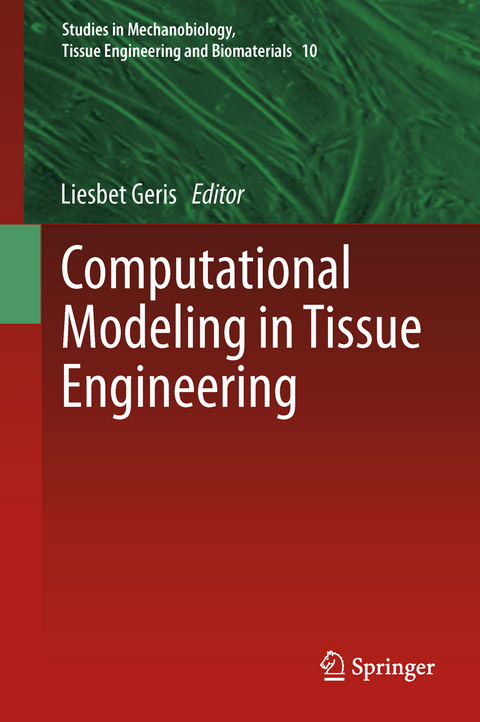
Computational Modeling in Tissue Engineering
Springer Berlin (Verlag)
978-3-642-43078-7 (ISBN)
One of the major challenges in tissue engineering is the translation of biological knowledge on complex cell and tissue behavior into a predictive and robust engineering process. Mastering this complexity is an essential step towards clinical applications of tissue engineering. This volume discusses computational modeling tools that allow studying the biological complexity in a more quantitative way. More specifically, computational tools can help in: (i) quantifying and optimizing the tissue engineering product, e.g. by adapting scaffold design to optimize micro-environmental signals or by adapting selection criteria to improve homogeneity of the selected cell population;(ii) quantifying and optimizing the tissue engineering process, e.g. by adapting bioreactor design to improve quality and quantity of the final product; and (iii) assessing the influence of the in vivo environment on the behavior of the tissue engineering product, e.g. by investigating vascular ingrowth.The book presents examples of each of the above mentioned areas of computational modeling. The underlying tissue engineering applications will vary from blood vessels over trachea to cartilage and bone. For the chapters describing examples of the first two areas, the main focus is on (the optimization of) mechanical signals, mass transport and fluid flow encountered by the cells in scaffolds and bioreactors as well as on the optimization of the cell population itself. In the chapters describing modeling contributions in the third area, the focus will shift towards the biology, the complex interactions between biology and the micro-environmental signals and the ways in which modeling might be able to assist in investigating and mastering this complexity. The chapters cover issues related to (multiscale/multiphysics) model building, training and validation, but also discuss recent advances in scientific computing techniques that are needed to implement these models as well as new tools that can be used to experimentally validate the computational results.
In vivo, in vitro, in silico: computational tools for product and process design in tissue engineering.- Protein modeling and surface folding by limiting the degrees of freedom.- Adaptive Quasi-linear Viscoelastic Modeling.- Computational modeling of mass transport and its relation to cell behavior in tissue engineering constructs.- Computational Methods in the Modeling of Scaffolds for Tissue Engineering.- Computational Modeling of Tissue Engineering Scaffolds as Delivery Devices for Mechanical and Mechanically Modulated Signals.- Modeling the cryopreservation process of a suspension of cells: the effect of a sizedistributed cell population.- Mesenchymal Stem Cell Heterogeneity and Ageing in vitro - a Model Approach.- Image-based cell quality assessment: Modeling of cell morphology and quality for clinical cell therapy.- Continuum modelling of in vitro tissue engineering: a review.- Multiphysics Computational Modeling in Cartilage Tissue Engineering.- Oxygen Transport in Bioreactors for Engineered Vascular Tissues.- Multi-scale Modelling of Vascular Disease: Abdominal Aortic Aneurysm Evolution.- Computational Mechanobiology in Cartilage and Bone Tissue Engineering: From Cell Phenotype to Tissue Structure.- Mechanobiological modelling of angiogenesis impact on tissue engineering and bone regeneration.- Mathematical modeling of regeneration of a tissue-engineered trachea.
| Erscheint lt. Verlag | 9.11.2014 |
|---|---|
| Reihe/Serie | Studies in Mechanobiology, Tissue Engineering and Biomaterials |
| Zusatzinfo | XII, 444 p. |
| Verlagsort | Berlin |
| Sprache | englisch |
| Maße | 155 x 235 mm |
| Gewicht | 685 g |
| Themenwelt | Medizin / Pharmazie ► Physiotherapie / Ergotherapie ► Orthopädie |
| Naturwissenschaften ► Physik / Astronomie ► Angewandte Physik | |
| Technik ► Maschinenbau | |
| Schlagworte | Biological Response • Biological Substitutes • bioreactor design • Bone Tissue Modeling • Cartilage Tissue Modeling • Heart Tissue Modeling • Liver Tissue Modeling • Micro-Environmental Signals |
| ISBN-10 | 3-642-43078-3 / 3642430783 |
| ISBN-13 | 978-3-642-43078-7 / 9783642430787 |
| Zustand | Neuware |
| Informationen gemäß Produktsicherheitsverordnung (GPSR) | |
| Haben Sie eine Frage zum Produkt? |
aus dem Bereich


